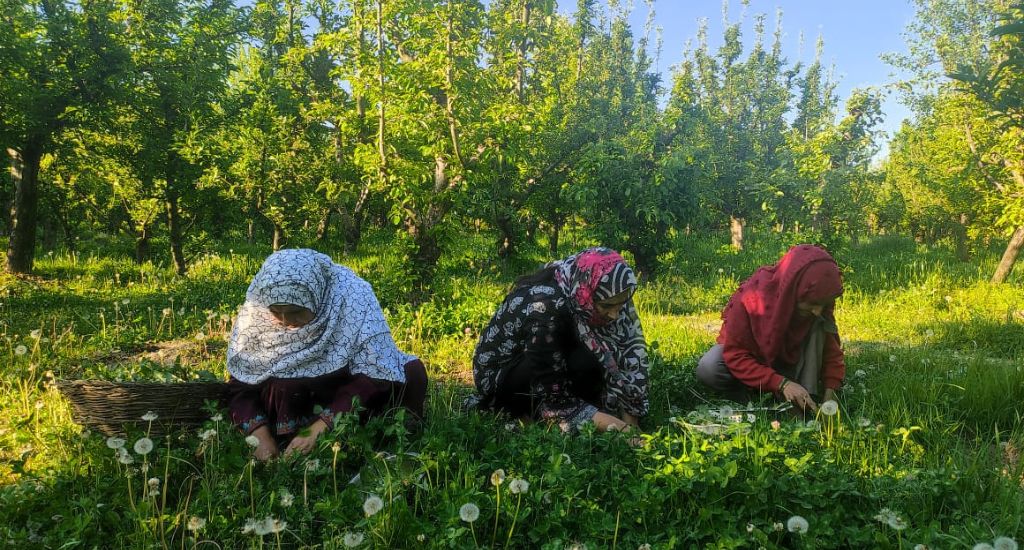
A dose of dandelion soothes Kashmir’s palate and health
Called ‘haend’, Kashmiris consider a wild variety of dandelion a miracle herb that cures a host of ailments. They eat it fresh, cooked and dried.

Called ‘haend’, Kashmiris consider a wild variety of dandelion a miracle herb that cures a host of ailments. They eat it fresh, cooked and dried.
A carpet of yellow flowers covers the ridge along the foothills of the snow-capped Zabarwan in Srinagar’s unblemished, outdoorsy stretch abutting the city’s landmark Dal Lake in springtime.
Amidst the pristine surroundings, Shahzada Bano, a middle-aged woman from Srinagar in Kashmir, picks the flowers and leaves, and puts the harvest in a wicker basket.
What look like dainty daisies to the unpractised eye are actually dandelions – considered a weed by farmers, but its leaf is a favoured medicinal herb that Kashmiris call “haend”.
Well, one person’s weed is another’s magic potion. Bano will take home the Taraxacum officinale, a most common variety of dandelion, and store the leaves for her daughter.
“My daughter is expecting a baby by early autumn. I am going to sun dry these leaves. I will feed her these during her post-delivery period,” she said.
Also Read | Kashmir’s farmers switch from growing apples to exotic greens

Kashmiris have been using “haend” as a cure-all for a variety of maladies. It is believed that the herb increases the volume of blood and haemoglobin in the body and hence, is fed as a postpartum remedy, or to treat anaemia and polycystic ovarian disease.
The word dandelion comes from the French version “dent de lion” which means lion’s tooth, and refers to the toothed appearance of a plant’s leaves. Dent de lions evolved about 30 million years ago and have likely been an important source of food and medicine for people since the beginning of humanity.
I have seen haend being served to pregnant women and nursing mothers since my childhood. The herb is also used to treat menstrual problems.
According to Dr Riyaz Ahmad, an Unani medico from Ganderbal district of central Kashmir, “haend” has many healing uses in Ayurveda and Unani branches of medicine. The green leaves of the herb are full of iron and these have anti-inflammatory properties too.
“Haend” is said to be rich in antioxidants and minerals such as iron, potassium and calcium, as well as a storehouse of fibre helpful for the digestive system. Research indicates that the herb can help in weight loss too, but more studies are needed to establish the claim.
Ahmad said the leaves are also used for controlling the blood sugar and blood pressure of patients, while the roots aid digestion. His list of dandelion goodness goes on: beneficial for the skin, bones, and the immune system.
Expanding interest in traditional medicine is fostering a potentially lucrative new niche market for rural women who sell a portion of their dried “haend” collection to town folks. People use the herb nowadays primarily as a complement to mainstream medicine.
Also Read | Kashmiri harissa: From posh grub to comfort food

”I have seen haend being served to pregnant women and nursing mothers since my childhood. The herb is also used to treat menstrual problems. I collect a good quantity of haend every year. I sell the sundried herb in the market during winters and earn good money,” said Sameena Jan, 37, of Kremshar village in central Kashmir’s Budgam district.
The dandelion grows and blossoms abundantly in the wild the whole of spring and partly in summer – on meadows, crop fields, orchards, everywhere. That’s when Kashmiri women pick the fresh leaves. The herb in its dried form is available in all seasons.
“I use it at home and give away a lot of dried herbs to relatives, friends and neighbours,” Bano said.
As Kashmir is getting increasingly urbanised and people are veering more towards office jobs, fewer women are seen collecting “haend” in cities and towns. But rural women still go out in hordes to pluck the herb from meadows and orchards.
Kashmiris have been eating freshly picked dandelion leaves in curries for centuries. Tariq Ahmad Waza, a cook in Srinagar, said “haend” tastes best when cooked with egg or meat.
The entire plant is usable. The roots can be dried to make a tea-type drink, flowers can be used to make fritters, and the young leaves can be consumed raw or cooked like spinach. It’s a versatile plant.
Also Read | Shrinking Wular Lake shrivels water chestnut harvests in Kashmir

There are a host of recipes, some are region specific. People make a lot of meals using dandelions, but the one that stands out is the flower fritters. The recipe uses the entire head of the dandelion – green and all – and dips it in a batter and fries it up.
The demand for dried dandelion reaches its peak during the harsh winter months when fresh vegetables are not easily available. “I use to sell 30 to 40 gunny sacks of dried haend every winter,” said Mohammad Sultan, a vegetable seller in central Kashmir’s Hazratbal.
The lead image at the top shows a group of women picking wild dandelions in an orchard in central Kashmir’s Budgam (Photo by Nasir Yousufi)
Nasir Yousufi is a journalist based at Srinagar.